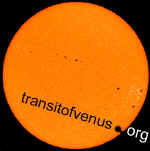The transit of Venus was a recurring topic at the 2003 Annual Conference of the Great Lakes Planetarium Association (GLPA). Chuck Bueter and Art Klinger showed excerpts from the Transit of Venus program in the Shafran Planetarium. Gene Zajac and Bueter hosted a Transit of Venus (TV) Screen workshop to make rear-projection viewing devices for telescopes. David Hurd revealed the hidden value of a familiar model to illustrate the periodicity of inferior conjunctions with his Trippensee planetarium demonstration. Don Tuttle crafted Transit Time, his latest scientifically-accurate quilt that commemorates the transit of Venus both in function and form. And GLPA members enjoyed viewing large sunspot groups with a Sunspotter from Learning Technologies Inc. and with Solar Shades from Rainbow Symphony.
In many discussions we addressed plans for the 2004 transit of Venus, including an exchange of artwork specifically solicited to commemorate this event. Another outcome of those discussions was that we learned John Philip Sousa's Transit of Venus March band arrangement is available for $25.00 (plus UPS shipping) through The Detroit Concert Band, Inc. at (480) 948-9870. You may order a reprint of each published part on 8.5 x 11-inch pages and reproduce as many copies for your own use as necessary.
We welcome more images of transit-related pictures from the astronomy
enthusiasts at the GLPA 2003 Annual Conference.
Transit of Venus Program
 Chuck
Bueter gave this description of the Transit of Venus program
prior to his and Art Klinger's showing videotape excerpts from the forthcoming Transit
of Venus. The program
debuted October 23, 2003 at the Shafran Planetarium in the Cleveland Museum of
Natural History during the 2003 Annual Conference of the Great
Lakes Planetarium Association (GLPA). It will be shipped to all GLPA
members in November 2003.
Chuck
Bueter gave this description of the Transit of Venus program
prior to his and Art Klinger's showing videotape excerpts from the forthcoming Transit
of Venus. The program
debuted October 23, 2003 at the Shafran Planetarium in the Cleveland Museum of
Natural History during the 2003 Annual Conference of the Great
Lakes Planetarium Association (GLPA). It will be shipped to all GLPA
members in November 2003.
Trippensee Planetarium Demonstration
 David Hurd points out Edmond Halley sighting (below).
David Hurd points out Edmond Halley sighting (below).

 Edmond Halley predicts a forthcoming transit with the aid of a Trippensee
planetarium; images courtesy of David Hurd.
Edmond Halley predicts a forthcoming transit with the aid of a Trippensee
planetarium; images courtesy of David Hurd.
 David Hurd reveals that Venus orbits 13 times to earth's 8 orbits. His
demonstration with a Trippensee
planetarium illustrates why 8 years pass between consecutive inferior
conjunctions of earth and the inner planetarium model, shown to be planet Venus.
David Hurd reveals that Venus orbits 13 times to earth's 8 orbits. His
demonstration with a Trippensee
planetarium illustrates why 8 years pass between consecutive inferior
conjunctions of earth and the inner planetarium model, shown to be planet Venus.
Transit of Venus (TV) Screen Workshop
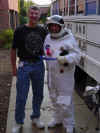 Chuck Bueter (left) and astrobusnaut Gene Zajac presented a workshop
on constructing rear- projecting Transit of Venus (TV) Screens.
Chuck Bueter (left) and astrobusnaut Gene Zajac presented a workshop
on constructing rear- projecting Transit of Venus (TV) Screens.
 Gene Zajac and Chuck Bueter distributed a handout related to a
make-it-and-take-it workshop during the 2003 Annual Conference of the Great
Lakes Planetarium Association (GLPA).
Gene Zajac and Chuck Bueter distributed a handout related to a
make-it-and-take-it workshop during the 2003 Annual Conference of the Great
Lakes Planetarium Association (GLPA).
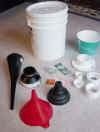
 Preparing for the make-it-and-take-it workshop, Zajac and Bueter evaluate
inexpensive materials for the solar-viewing device. The toilet plunger was
only a limited success.
Preparing for the make-it-and-take-it workshop, Zajac and Bueter evaluate
inexpensive materials for the solar-viewing device. The toilet plunger was
only a limited success.


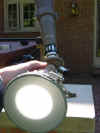
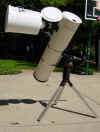 Outdoor trials (far left) help to refine the final products, which feature an
oil funnel and a plastic bucket.
Outdoor trials (far left) help to refine the final products, which feature an
oil funnel and a plastic bucket.
DonTuttle's Transit Time Quilt Debuts

Don
Tuttle created Transit Time, a functional quilt that commemorates the
2004 transit of Venus. Don generously sent it to be exhibited even though
he himself was unable to attend the 2003 GLPA conference. Individuals and
institutions may borrow Don's handiwork to dovetail with transit of Venus
programming. Contact Chuck Bueter
for availability and to schedule its use and display. (Image on right
courtesy of Marc Rouleau.)
Viewing Sunspot Groups
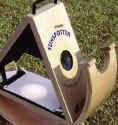 A
Sunspotter (courtesy of Learning Technologies
Inc.) and Solar Shades (courtesy of Rainbow
Symphony) allowed all GLPA members to watch safely the giant sunspot groups
that emerged during the conference; image courtesy of LTI.
A
Sunspotter (courtesy of Learning Technologies
Inc.) and Solar Shades (courtesy of Rainbow
Symphony) allowed all GLPA members to watch safely the giant sunspot groups
that emerged during the conference; image courtesy of LTI.
 Susan Button observes large sunspots through a hydrogen alpha-filtered
telescope.
Susan Button observes large sunspots through a hydrogen alpha-filtered
telescope.

 Two large sunspot groups glide across the face of the sun during the 2003 GLPA
Annual Conference; image at right courtesy of SOHO.
Two large sunspot groups glide across the face of the sun during the 2003 GLPA
Annual Conference; image at right courtesy of SOHO.
